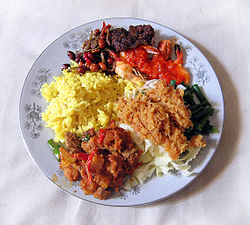This article needs additional citations for verification .(March 2013) |
 Vegetable urap | |
| Alternative names | Urab, Urap-urap, krawu |
|---|---|
| Course | Side dish |
| Place of origin | Indonesia |
| Region or state | Central Java and Yogyakarta |
| Serving temperature | Mostly served with main course |
| Main ingredients | Steamed vegetable salad, shredded coconut dressing |

Urap (sometimes spelled urab or in its plural form urap-urap) is a salad dish of steamed or boiled vegetables mixed with seasoned and spiced grated coconut for dressing. [1] It is commonly found in Indonesian cuisine, more precisely Javanese cuisine. Urap can be consumed on its own as a salad for vegetarian meals [2] or as a side dish. Urap is usually found as a prerequisite side dish of Javanese tumpeng , a cone-shaped rice mound surrounded with assorted dishes, as well as part of a nasi kuning dish. In Balinese cuisine, it is known as urab sayur.
